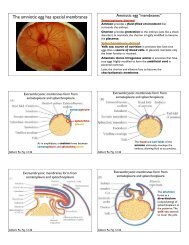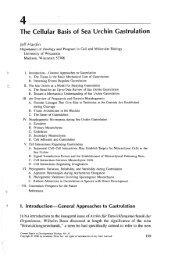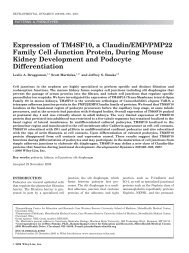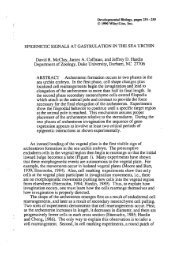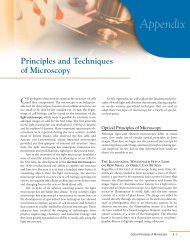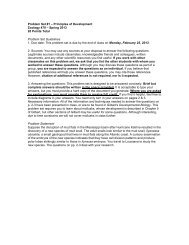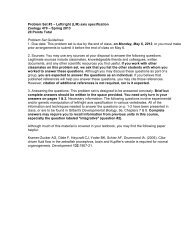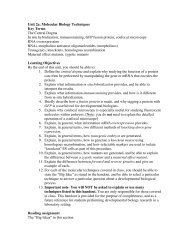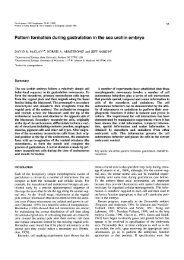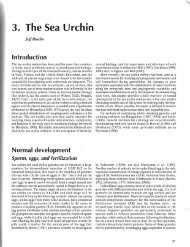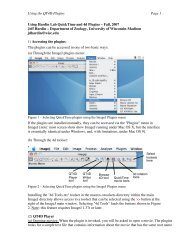Printed in Great - Jeff Hardin
Printed in Great - Jeff Hardin
Printed in Great - Jeff Hardin
Create successful ePaper yourself
Turn your PDF publications into a flip-book with our unique Google optimized e-Paper software.
Development 103, 211-230 (1988)<br />
<strong>Pr<strong>in</strong>ted</strong> <strong>in</strong> <strong>Great</strong> Brita<strong>in</strong> © The Company of Biologists Limited 1988<br />
The behaviour and function of bottle cells dur<strong>in</strong>g gastrulation of<br />
Xenopus laevis<br />
JEFF HARDIN 1 * and RAY KELLER 2<br />
1 Biophysics and Medical Physics Group and 2 Department of Zoology, University of California, Berkeley, CA 94720, USA<br />
Present address: Department of Zoology, Duke University, Durham. North Carol<strong>in</strong>a, 27706, USA<br />
Summary<br />
The behaviour of bottle cells <strong>in</strong> normal and microsurgically<br />
altered gastrulae and <strong>in</strong> cultured explants of<br />
Xenopus laevis was analysed, us<strong>in</strong>g time-lapse micrography,<br />
scann<strong>in</strong>g electron microscopy (SEM) and cell<br />
trac<strong>in</strong>g with fluoresce<strong>in</strong> dextran am<strong>in</strong>e (FDA). The<br />
results shed new light on the function of bottle cells.<br />
Bottle cells form<strong>in</strong>g <strong>in</strong> vivo show a predom<strong>in</strong>antly<br />
animal-vegetal apical contraction and a concurrent<br />
apical-basal elongation, whereas those form<strong>in</strong>g <strong>in</strong><br />
cultured explants show uniform apical contraction<br />
and rema<strong>in</strong> rotund. Bottle cells form<strong>in</strong>g <strong>in</strong> embryos<br />
with fewer subblastoporal cells contract more uniformly<br />
than those <strong>in</strong> normal embryos and release of<br />
normal bottle cells from supra- and subblastoporal<br />
cells results <strong>in</strong> immediate loss of the bottle shape.<br />
These results, and an analysis of the effects of bottle<br />
cell formation on the shapes and movements of surround<strong>in</strong>g<br />
tissues, show that unique shape of bottle cells<br />
Introduction<br />
The unique shape of the 'bottle' or 'flask' cells and<br />
their position at the site of blastopore formation<br />
suggested to early embryologists that they must play a<br />
major role <strong>in</strong> the gastrulation of amphibians<br />
(Rhumbler, 1902; Ruff<strong>in</strong>i, 1925). There are two not<br />
mutually exclusive notions of how these cells function<br />
<strong>in</strong> gastrulation. Rhumbler (1902) & Holtfreter<br />
(1943a,b) argued that bottle cells <strong>in</strong>vade the <strong>in</strong>terior<br />
of the gastrula because the alkal<strong>in</strong>e environment<br />
there (Buytendijk & Woerdeman, 1927; Stableford,<br />
1949; Gillespie, 1983) stimulates motility of their<br />
<strong>in</strong>ner, basal ends. Isolated bottle cells cultured on<br />
glass <strong>in</strong> alkal<strong>in</strong>e medium attach, spread and migrate<br />
on the substratum by their basal ends, whereas their<br />
apical ends are nonadhesive and rema<strong>in</strong> <strong>in</strong>active<br />
211<br />
and their probable function <strong>in</strong> development are not<br />
<strong>in</strong>tr<strong>in</strong>sic properties but result from a modulation of<br />
the effect of a uniform and <strong>in</strong>tr<strong>in</strong>sic apical contraction<br />
by the geometric and mechanical properties of the<br />
surround<strong>in</strong>g tissue. Mechanical simulations of bottle<br />
cell formation, us<strong>in</strong>g the f<strong>in</strong>ite element method,<br />
suggest how the site of bottle cell formation and the<br />
thickness and stiffness of adjacent tissues might<br />
change the effects of their formation. These results<br />
and FDA mark<strong>in</strong>g of prospective bottle cells and the<br />
adjacent deep mesodermal cells suggest that bottle<br />
cells function dur<strong>in</strong>g their formation to <strong>in</strong>itiate the<br />
<strong>in</strong>volution of the prospective mesodermal mantle.<br />
Later they respread to deepen the archenteron and to<br />
form its peripheral wall.<br />
Key words: <strong>in</strong>vag<strong>in</strong>ation, bottle cells, gastrulation,<br />
Xenopus.<br />
(figs 7, 8, Holtfreter, 1944). Likewise, when explanted<br />
onto a substratum of endoderm, bottle cells<br />
form a pit rem<strong>in</strong>iscent of the archenteron (fig. 16,<br />
Holtfreter, 1944). If bottle cells were to behave <strong>in</strong> this<br />
way <strong>in</strong> vivo, it was thought that they would drag<br />
surround<strong>in</strong>g tissues along with them, due to the firm<br />
association of surface cells <strong>in</strong> what Holtfreter<br />
(1943a,b) believed to be a syncytial 'surface coat'.<br />
Bottle cells could also act through their change <strong>in</strong><br />
shape, rather than their <strong>in</strong>vasiveness, by bend<strong>in</strong>g the<br />
sheet of cells to form a true <strong>in</strong>vag<strong>in</strong>ation as their<br />
apices contract (see Baker, 1965). Lewis (1947),<br />
formalized the relation between cell shape and bend<strong>in</strong>g<br />
of the cell sheet to form an <strong>in</strong>vag<strong>in</strong>ation with a<br />
mechanical model, made of rubber and brass. Odell<br />
and others did the same by computer simulation of<br />
cell shape changes (Odell etal. 1981; Hilfer & Hilfer,
212 J. Hard<strong>in</strong> and R. Keller<br />
1983). The relation of cell shape to bend<strong>in</strong>g of<br />
epithelial sheets has been reviewed <strong>in</strong> a number of<br />
publications (Gustafson & Wolpert, 1967; Schroeder,<br />
1970; Burnside, 1973; Karfunkel, 1974; Schoenwolf,<br />
1982; Ettensohn, 1985).<br />
Several old observations and more recent experimental<br />
evidence suggest that amphibian bottle cells<br />
may have a more limited role, or perhaps a role<br />
different from those described above. Bottle cells<br />
disappear before the archenteron ceases to <strong>in</strong>crease<br />
<strong>in</strong> depth (see Keller, 1986). Surgical extirpation of<br />
bottle cells <strong>in</strong> Xenopus results only <strong>in</strong> truncation of<br />
the peripheral archenteron (Keller, 1981; see also<br />
Cooke, 1975), which is the area to which they<br />
normally give rise (Keller, 1975). Moreover, most of<br />
the depth of the archenteron forms by <strong>in</strong>volution<br />
<strong>in</strong>stead of the <strong>in</strong>vag<strong>in</strong>ation associated with bottle cell<br />
formation (Keller, 1986). F<strong>in</strong>ally, the prospective<br />
fates and behaviour of bottle cells <strong>in</strong> the Mexican<br />
axolotl (Lundmark, 1986) and other urodeles (Holtfreter,<br />
1944) are different from their counterparts <strong>in</strong><br />
Xenopus (Keller, 1986). Look<strong>in</strong>g at other systems,<br />
the careful studies of Ettensohn (1984) on primary<br />
<strong>in</strong>vag<strong>in</strong>ation of the sea urch<strong>in</strong> revealed no clear<br />
relationship between cell shape and <strong>in</strong>vag<strong>in</strong>ation of<br />
the vegetal plate. Likewise, extensive analysis of<br />
avian neurulation suggests that the relation of cell<br />
shape change to <strong>in</strong>vag<strong>in</strong>ation and the mechanisms of<br />
such shape change may be more complex than previously<br />
thought (see Schoenwolf, 1985; Smith &<br />
Schoenwolf, 1987). The same applies to lens formation<br />
(Zwaan & Pearce, 1971; Hendrix & Zwaan,<br />
1974).<br />
Us<strong>in</strong>g several methods, we will show that the<br />
unique shape of bottle cells and their function <strong>in</strong><br />
Xenopus laevis are not <strong>in</strong>tr<strong>in</strong>sic to these cells but are<br />
dependent on a simple <strong>in</strong>tr<strong>in</strong>sic behaviour, apical<br />
constriction, act<strong>in</strong>g <strong>in</strong> a specific mechanical and<br />
geometrical context. In this context, apical constriction<br />
has the limited but perhaps important function of<br />
<strong>in</strong>itiat<strong>in</strong>g the <strong>in</strong>volution of the deep, lead<strong>in</strong>g edge of<br />
the <strong>in</strong>volut<strong>in</strong>g marg<strong>in</strong>al zone (IMZ) prior to its<br />
convergence and extension later <strong>in</strong> gastrulation.<br />
Materials and methods<br />
Obta<strong>in</strong><strong>in</strong>g embryos, culture methods, cell mark<strong>in</strong>g<br />
Xenopus laevis embryos were obta<strong>in</strong>ed by standard<br />
methods and dejellied chemically (0-6 g Tris, 1 -75 g cyste<strong>in</strong>e<br />
hydrochloride, <strong>in</strong> 50 ml distilled water adjusted to pH7-8).<br />
Vitell<strong>in</strong>e envelopes were removed manually with sharpened<br />
watchmaker's forceps (Dumont no. 5). Embyros were<br />
cultured <strong>in</strong> modified Niu-Twitty solution (buffered at<br />
pH 7-4 with 5 mM-Hepes) or <strong>in</strong> Danilchik's solution (Keller<br />
et al. 1985a,b). Microsurgery was done on a Plastic<strong>in</strong>e base<br />
(Harbutt's Plastic<strong>in</strong>e Limited, Bath, England) with eyebrow<br />
hairs and hair loops. For trac<strong>in</strong>g of cell fates, embryos<br />
were <strong>in</strong>jected with fluoresce<strong>in</strong> dextran am<strong>in</strong>e (FDA) cell<br />
l<strong>in</strong>eage tracer, obta<strong>in</strong>ed from Robert Gimlich (see Gimlich<br />
& Cooke, 1984), at the 1-cell stage, and the appropriate<br />
regions of labelled embryos were grafted homotypically to<br />
unlabelled embryos, us<strong>in</strong>g eyebrow hairs. To generate cuts<br />
of uniform, repeatable character for tissue gap<strong>in</strong>g studies,<br />
an electric, vibrat<strong>in</strong>g microknife (60cycles" 1 ) of tungsten<br />
developed for microsurgery <strong>in</strong> this laboratory by Chris<br />
Luzzio, was used. The develop<strong>in</strong>g embryos were fixed <strong>in</strong><br />
4% formaldehyde at the appropriate stage, embedded <strong>in</strong><br />
Paraplast, sectioned at 10 ftm and the labelled cells visualized<br />
by epifluorescence microscopy. Stag<strong>in</strong>g was accord<strong>in</strong>g<br />
to Nieuwkoop & Faber (1967).<br />
C<strong>in</strong>emicrography, videomicrography, SEM and<br />
morphometrics<br />
C<strong>in</strong>emicrography was done with a Bolex-Sage or Arriflex<br />
camera and <strong>in</strong>tervalometer, us<strong>in</strong>g Kodak Plus X reversal or<br />
Ektachrome Video-news film. Videomicrography was done<br />
with a Panasonic recorder, camera and monitor. A Zeiss<br />
Standard microscope and low-angle epi-illum<strong>in</strong>ation were<br />
used throughout. The shapes of the apices of the form<strong>in</strong>g<br />
bottle cells and of the adjacent marg<strong>in</strong>al zone and vegetal<br />
cells were determ<strong>in</strong>ed by trac<strong>in</strong>g cell profiles with a Numonics<br />
digitizer, supplemented by an Apple 11+ computer and<br />
a morphometrics program written for this laboratory by<br />
Chet Regen. The morphometric parameters will be described<br />
<strong>in</strong> the Results.<br />
Simulation of bottle cell function with an<br />
axisymmetric f<strong>in</strong>ite element program<br />
In order to determ<strong>in</strong>e what effect specific bottle cell<br />
behaviours could be expected to have on surround<strong>in</strong>g<br />
tissues, we used an axisymmetric f<strong>in</strong>ite element formulation<br />
developed by Louis Cheng (see Hard<strong>in</strong> & Cheng, 1986).<br />
Briefly, the formulation models the stretch<strong>in</strong>g, bend<strong>in</strong>g and<br />
shear<strong>in</strong>g of rotationally symmetric shell-like bodies. The<br />
shape of the embryo is specified by a meridian curve rotated<br />
about the axis of symmetry to yield a three-dimensional<br />
shape. The deformation of this model embryo under the<br />
<strong>in</strong>fluence of various forces can be simulated us<strong>in</strong>g a computer<br />
algorithm described elsewhere (Cheng, 1987a).<br />
Bottle cells do form symmetrically about the animalvegetal<br />
axis, although not all at the same time. In vivo, the<br />
process beg<strong>in</strong>s dorsally <strong>in</strong> late stage 9, proceeds laterally<br />
and is completed ventrally by stage 10-5. S<strong>in</strong>ce the process<br />
of bottle cell formation and the associated deformation of<br />
the embryo do not appear to differ around the blastopore,<br />
we idealize bottle cell formation as occurr<strong>in</strong>g simultaneously<br />
<strong>in</strong> all sectors.<br />
Results<br />
Normal bottle cell formation<br />
The prospective bottle cells form from the six to eight<br />
tiers of superficial epithelial cells that lie at the<br />
vegetal end of the <strong>in</strong>volut<strong>in</strong>g marg<strong>in</strong>al zone (IMZ)
and immediately animal to the much larger epithelial<br />
cells that comprise the vegetal region (Fig. 1). The<br />
earliest stages of their formation are characterized by<br />
apices that (1) are smaller <strong>in</strong> area than the surround<strong>in</strong>g<br />
IMZ cells; (2) have a higher density of microvilli<br />
on their apices (Figs 1, 2A) and (3) appear grey by<br />
virtue of <strong>in</strong>creased apical pigment concentration<br />
(Fig. 2A). The first bottle cells to form are not<br />
necessarily neighbours nor are groups necessarily<br />
contiguous (Fig. 1). Their apices are pleiomorphic<br />
and most lack obvious major and m<strong>in</strong>or axes (Figs 1,<br />
2A). The sagittal profile of the bottle cell area is<br />
deformed very little at this early stage (Fig. 2A). As<br />
bottle cell formation proceeds, their apices darken,<br />
form a larger, more contiguous array and acquire an<br />
elongate shape with their long axes com<strong>in</strong>g to lie<br />
parallel to the circumference of the mass of large cells<br />
at the vegetal pole (Fig. 2B). Dur<strong>in</strong>g this period, the<br />
Function of bottle cells <strong>in</strong> Xenopus gastrulation 213<br />
bottle cell region bends and the blastoporal groove<br />
forms along bottle cells, accompanied by the outward<br />
bulg<strong>in</strong>g of the IMZ above the groove (Fig. 2B).<br />
Subsequently, the constricted apices of the bottle<br />
cells jo<strong>in</strong> to form the blastoporal pigment l<strong>in</strong>e characteristic<br />
of the stage 10 or 10+ embryo (Nieuwkoop &<br />
Faber, 1967); (Fig. 2C). The apices become highly<br />
elongate and aligned, and the bottle cell region<br />
<strong>in</strong>vag<strong>in</strong>ates to form the blastoporal groove (Fig. 2C).<br />
Early form<strong>in</strong>g bottle cells tend to lie <strong>in</strong> clumps and<br />
have more isomorphic apices than those form<strong>in</strong>g<br />
later, which have very elongate apices (Fig. 3A—C).<br />
As bottle cells form, the IMZ cells immediately above<br />
them become elongate <strong>in</strong> the animal-vegetal direction<br />
whereas those at greater distances rema<strong>in</strong><br />
rounded (Fig. 3D). The same is true of the vegetal<br />
cells adjacent to the bottle cells (Fig. 3D). Bottle cell<br />
formation progresses laterally and f<strong>in</strong>ally ventrally,<br />
Fig. 1. A scann<strong>in</strong>g electron micrograph of an early stage of bottle cell formation <strong>in</strong> Xenopus laevis shows the form<strong>in</strong>g<br />
bottle cells, characterized by larger numbers of microvilli on their apical surfaces. The ma<strong>in</strong> population of bottle cells<br />
lies between the white brackets and its boundary with the large vegetal cells (vc) is outl<strong>in</strong>ed by small po<strong>in</strong>ters. More<br />
bottle cells form from the <strong>in</strong>volut<strong>in</strong>g marg<strong>in</strong>al zone {IMZ) epithelial cells. Some form near or adjacent to the ma<strong>in</strong><br />
population (medium po<strong>in</strong>ters) and some form four or five tiers of cells above the ma<strong>in</strong> population (large po<strong>in</strong>ters).<br />
Some cells fail to participate <strong>in</strong> bottle cell formation (asterisks) although they are surrounded or nearly surrounded by<br />
bottle cells. Magnification: x294. Bar, 25jxm.<br />
\ L.
214 J. Hard<strong>in</strong> and R. Keller<br />
surround<strong>in</strong>g the vegetal cells (the yolk plug) <strong>in</strong> a<br />
manner <strong>in</strong>dist<strong>in</strong>guishable from what has been described<br />
for the dorsal region.<br />
Time-lapse micrography shows that, as their apices<br />
contract, the prospective dorsal bottle cells move<br />
vegetally, aga<strong>in</strong>st the boundary of the large vegetal<br />
cells, to form the blastoporal pigment l<strong>in</strong>e (BPL)<br />
(Fig. 4A,B). The dorsal marg<strong>in</strong>al zone cells ly<strong>in</strong>g at<br />
or just beyond the edge of the prospective bottle cell<br />
region move some distance toward the BPL whereas<br />
the correspond<strong>in</strong>g vegetal cells move less or not at all<br />
(Fig. 4C). As the prospective bottle cell region contracts<br />
<strong>in</strong>to the BPL <strong>in</strong> lateral and ventral sectors, both<br />
the animal boundary (filled circles, Fig. 4D) and<br />
vegetal boundary (filled squares, Fig. 4D) of the<br />
prospective bottle cell region move vegetally
(Fig. 4E,F) and appear to constrict the vegetal cell<br />
mass. Note that the large area org<strong>in</strong>ally occupied by<br />
the prospective bottle cells (shaded areas, Fig. 4A,D)<br />
disappears <strong>in</strong>to the BPL by stage 10-5 (Fig. 4E,F) and<br />
the vegetal cell mass is decreased <strong>in</strong> area by about<br />
30% at the end of bottle cell formation (Fig. 4E,F).<br />
Quantitative analysis of changes <strong>in</strong> cell shape among<br />
bottle cells and adjacent tissues<br />
Quantitative analysis of the shape changes of bottle<br />
cells and adjacent cells under normal and experimental<br />
conditions clarifies the cellular mechanics of bottle<br />
cell function. Two morphometric parameters are<br />
relevant. First, the length-width ratio of <strong>in</strong>dividual<br />
cells (l/w). This is the length of the longest l<strong>in</strong>e that<br />
Function of bottle cells <strong>in</strong> Xenopus gastrulation 215<br />
can be placed with<strong>in</strong> the cell divided by the profile of<br />
the cell projected onto a l<strong>in</strong>e perpendicular to the<br />
long axis (Fig. 5, top panel). The second is the profile<br />
of the cell projected onto the animal-vegetal meridian<br />
of the embryo divided by the profile projected<br />
onto a latitude l<strong>in</strong>e perpendicular to the animalvegetal<br />
meridians (y/x) (Fig. 5, bottom panel). The<br />
former is a measure of the elongation of the apices of<br />
the cells and the latter is a measure of the orientation<br />
of any cell that shows significant elongation. Changes<br />
<strong>in</strong> these parameters summarize change <strong>in</strong> shape of the<br />
bottle cell apices (Fig. 5). As bottle cell apices contract,<br />
they become elongate <strong>in</strong> shape (mean l/w rises<br />
from 1-6 to over 4) and align parallel to their<br />
boundary with the large vegetal cells (y/x falls from<br />
Fig. 2. The early (A), middle (B) and late (C) stages of bottle cell formation are illustrated by light microscopy of their<br />
apical surfaces (upper left <strong>in</strong>sets), scann<strong>in</strong>g electron micrography of the apical surfaces (centre) and sagittal profiles<br />
(right) of the bottle cell region at each stage. Magnification: light micrographs, xlOO, bar, 100^m; SEMs, x550,<br />
bar, 20^m; SEM <strong>in</strong>set <strong>in</strong> C, X2100, bar, 5j«n; profiles, X135, bar, 100jim.
216 J. Hard<strong>in</strong> and R. Keller<br />
Fig. 3. The late stage of dorsal bottle cell formation is illustrated by SEMs of the centre (A), left end (B) and right end<br />
(C) of the blastoporal pigment l<strong>in</strong>e at stage 10. The morphology of the apices of cells <strong>in</strong> the adjacent <strong>in</strong>volut<strong>in</strong>g<br />
marg<strong>in</strong>al zone (IMZ) and vegetal cells (vc) are also shown (D). Magnification: A-C, x250, bar, 20/^m; D, x90.<br />
0-9 to 0-4). At the same time, the IMZ cells above the<br />
bottle cells become elongate (mean 1/w changes from<br />
1-4 to 1-9) and align perpendicular to the long axes of<br />
the bottle cell apices (y/x rises from 0-9 to 1-7). To a<br />
lesser extent, the vegetal cells below the bottle cells<br />
do the same (Fig. 3D; Fig. 5).<br />
Comparison of bottle cell behaviour with and<br />
without adjacent tissues<br />
Is the development of the characteristic apical shape<br />
and the directional, vegetal displacement of the<br />
form<strong>in</strong>g bottle cells autonomous to these cells or is<br />
the anisotropy imposed by neighbour<strong>in</strong>g tissues on an<br />
<strong>in</strong>tr<strong>in</strong>sically isotropic motile activity? Alter<strong>in</strong>g the<br />
relationship of bottle cells to the surround<strong>in</strong>g tissues<br />
shows that the latter is the case.<br />
Apices of prospective bottle cells, which were<br />
excised from the dorsal side at stage 9 and cultured on<br />
a nonadhesive agarose substratum, contract uniformly,<br />
form<strong>in</strong>g rounded apices (Fig. 6A-C) rather<br />
than the elongate ones found <strong>in</strong> vivo (Figs 2C, 3D).<br />
The mean length/width ratio <strong>in</strong> culture was 1-6<br />
(S.E. =0-05) compared to 4-2 (S.E. = 0-17) <strong>in</strong> vivo<br />
(Fig. 5). Moreover, the apical-basal elongation<br />
characteristic of bottle cells <strong>in</strong> vivo does not occur <strong>in</strong><br />
culture (Fig. 6D). Instead, an unconstra<strong>in</strong>ed sheet of<br />
form<strong>in</strong>g bottle cells bends to form a cup that nearly<br />
closes at the open end, with the basal ends of the<br />
nearly spherical cells form<strong>in</strong>g its outer surface (see<br />
Fig. 12A). This suggests that bottle cells have an<br />
Fig. 4. These diagrams are vegetal views of an embryo<br />
dur<strong>in</strong>g bottle cell formation, show<strong>in</strong>g trac<strong>in</strong>gs of cell<br />
movements recorded by time-lapse methods. The dorsal<br />
side is above <strong>in</strong> all illustrations. Us<strong>in</strong>g time-lapse<br />
record<strong>in</strong>g, the prospective dorsal bottle cell area was<br />
mapped, retrospectively, onto the stage-9 embryo<br />
(shaded area, A). The marg<strong>in</strong> of the prospective bottle<br />
cell area ly<strong>in</strong>g <strong>in</strong> the <strong>in</strong>volut<strong>in</strong>g marg<strong>in</strong>al zone (IMZ) is<br />
<strong>in</strong>dicated by filled circles; the vegetal boundary is<br />
<strong>in</strong>dicated by filled squares. Dur<strong>in</strong>g bottle cell formation,<br />
the marg<strong>in</strong>s of this area move <strong>in</strong>to the blastoporal<br />
pigment l<strong>in</strong>e of the stage 10+ early gastrula (arrows<br />
associated with circles and squares, B). Cells ly<strong>in</strong>g some<br />
distance away from the bottle cell region also move<br />
dur<strong>in</strong>g this period (arrows associated with triangles, C).<br />
The area of the rema<strong>in</strong><strong>in</strong>g prospective bottle cells, those<br />
of the lateral and ventral sectors, is mapped<br />
retrospectively on to the stage 10+ early gastrula (shaded<br />
area, D). The boundary of this area <strong>in</strong> the IMZ is<br />
<strong>in</strong>dicated by filled circles and its vegetal boundary is<br />
<strong>in</strong>dicated by filled squares. The movements of the IMZ<br />
boundary <strong>in</strong>to the blastoporal pigment l<strong>in</strong>e (bpf) of stage<br />
10-5 is shown (arrows, E). The movements of the vegetal<br />
boundary <strong>in</strong>to the blastoporal pigment l<strong>in</strong>e is also shown<br />
on a diagram of the same embryo (arrows, F). The darkly<br />
shaded patch <strong>in</strong> the prospective bottle cell region of A<br />
shows where patches of labelled bottle cells or bottle cells<br />
and underly<strong>in</strong>g deep cells were grafted <strong>in</strong>to unlabelled<br />
embryos to produce the results <strong>in</strong> Fig. 14D-G. Bar,<br />
0-5 ftm.
Function of bottle cells <strong>in</strong> Xenopus gastrulation 217<br />
B
218 J. Hard<strong>in</strong> and R. Keller<br />
autonomous tendency to contract uniformly and<br />
that the anisotropic contraction and apical-basal<br />
elongation seen <strong>in</strong> vivo are results of the mechanical<br />
constra<strong>in</strong>ts imposed by surround<strong>in</strong>g tissues. A<br />
reasonable hypothesis is that the large mass of vegetal<br />
cells cannot be displaced or deformed, thus constra<strong>in</strong><strong>in</strong>g<br />
the bottle cells to contract <strong>in</strong> the animal-vegetal<br />
l/w<br />
5 +<br />
3-<br />
1-<br />
2-0'<br />
1-5'<br />
y/x 10-<br />
0-5<br />
| | Early bottle cells<br />
I | Mid bottle cells<br />
Late bottle cells<br />
fr'~;Xyl Late: Bottle cells <strong>in</strong> culture<br />
[fcffijj] Late: Bottle cells <strong>in</strong> embryos m<strong>in</strong>us vegetal cell<br />
^ m Late: Bottle cells 2m<strong>in</strong> after lateral cuts<br />
direction and result<strong>in</strong>g <strong>in</strong> a r<strong>in</strong>g of elongate apices<br />
surround<strong>in</strong>g the vegetal cells.<br />
To test this notion, we removed a large fraction of<br />
the vegetal cells of the late blastula immediately<br />
before bottle cell formation had begun by suck<strong>in</strong>g<br />
them out with a f<strong>in</strong>e micropipette. Under these<br />
conditions, the bottle cell apices are much less<br />
Fig. 5. The mean length width ratios (l/w, above) and the mean projected length width ratios (y/x, below) of bottle<br />
cells (BC), marg<strong>in</strong>al zone cells (MZ), and vegetal cells (VEG) are shown for early, middle and late stages of bottle cell<br />
formation, and for late bottle cells under three different experimental conditions described <strong>in</strong> more detail <strong>in</strong> the text.<br />
The low marg<strong>in</strong>al zone <strong>in</strong>cludes the first four tiers of cells above the bottle cell region; the high marg<strong>in</strong>al zone <strong>in</strong>cludes<br />
rows 7 through 11. The standard error of the mean is <strong>in</strong>dicated at the top of each bar and the numbers above the bars<br />
<strong>in</strong>dicate the number of measurements, which were the same for l/w and y/x.<br />
VEG
Function of bottle cells <strong>in</strong> Xenopus gastrulation 219<br />
Fig. 6. An SEM shows a bottle cell region (BC) that formed <strong>in</strong> a region of the dorsal sector of a late blastula excised<br />
and cultured on a nonadhesive agarose substratum (A). The marg<strong>in</strong>al zone (IMZ) and vegetal region (v) are <strong>in</strong>dicated.<br />
A light micrograph shows the rounded, pigmented apices of the bottle cells <strong>in</strong> the specimen above (B). An SEM shows<br />
the uniformly rounded apices of bottle cells formed <strong>in</strong> cultured explants (C). An SEM of an isolated bottle cell region<br />
show<strong>in</strong>g 'bottle' cells (asterisks) radiat<strong>in</strong>g from the blastoporal pigment l<strong>in</strong>e ly<strong>in</strong>g hidden on the bottom (concave) side<br />
of the explant (D). Magnification: A, x70, bar, 0-2/OTI; B, X190, bar, 50ftm; C, X345, bar, 25/.im; D, xl35, bar,<br />
50/
220 /. Hard<strong>in</strong> and R. Keller<br />
primarily <strong>in</strong> the animal-vegetal direction, displac<strong>in</strong>g<br />
the IMZ vegetally rather than mov<strong>in</strong>g the vegetal<br />
region animally. Thus the IMZ epithelium is easier to<br />
deform than the vegetal epithelium, either because<br />
the latter are more rigid or because of their position at<br />
one pole of the embryo.<br />
However, the mechanical effect of bottle cell formation<br />
on the IMZ seems conf<strong>in</strong>ed to about six or<br />
seven tiers of cells above the bottle cells. The<br />
elongation and alignment of IMZ cells decreases with<br />
distance from the bottle cells. Beyond six or seven<br />
cell diameters, no effect is apparent and even late <strong>in</strong><br />
bottle cell formation the apices of cells <strong>in</strong> the upper<br />
IMZ are not significantly different from IMZ cells<br />
before bottle cell formation (MZ, high, Fig. 5). The<br />
greater distortion of cell apices near the bottle cells<br />
reflects greater tension there. To estimate the tension<br />
<strong>in</strong> the epithelial sheet, wounds of identical width and<br />
Fig. 7. An SEM shows apices of bottle formed <strong>in</strong> embryos from which most of the vegetal cells have been removed<br />
(A). Light micrographs (B) show the site of bottle cell formation as <strong>in</strong>dicated by the blastoporal pigment l<strong>in</strong>e <strong>in</strong> this<br />
embryo (left) and a control (right) embryo at stage 10. The vegetal cell mass <strong>in</strong> both is outl<strong>in</strong>ed with small po<strong>in</strong>ters.<br />
Magnification: A, x850, bar, 25 fim; B, x38.<br />
Fig. 8. Light micrographs show the bottle cell region (blastoporal pigment l<strong>in</strong>e, BPL) of an embryo at stage 10 (A), 30 s<br />
(B) and 4m<strong>in</strong> (C) after all lateral connections of the bottle cell region to the surround<strong>in</strong>g tissue were cut. Magnification:<br />
x59, bar, 01 mm.
depth were made with the vibrat<strong>in</strong>g tungsten microknife<br />
immediately above the bottle cells and at<br />
<strong>in</strong>creas<strong>in</strong>g distances toward the animal pole. The<br />
embryos were fixed 30 s after wound<strong>in</strong>g and the gape<br />
of the wounds measured. The mean gape is 300pm<br />
(±80S.D.) just above the bottle cells but decreases to<br />
105 jum (±23^ms.D.) at n<strong>in</strong>e to twelve tiers of cells<br />
away (Fig. 9A,C), beyond which there is no further<br />
decrease. This, and the shapes of IMZ cells described<br />
above, suggest that the mechanical <strong>in</strong>fluence of bottle<br />
cell formation is conf<strong>in</strong>ed to six or seven tiers of cells<br />
from the bottle cells. However, the tension <strong>in</strong> the first<br />
or second tier of IMZ cells is great and is perhaps near<br />
the normal limits of <strong>in</strong>tercellular adhesion; a common<br />
defect among laboratory-reared Xenopus is tear<strong>in</strong>g of<br />
the epithelium <strong>in</strong> this region.<br />
Bend<strong>in</strong>g of the IMZ dur<strong>in</strong>g bottle cell formation<br />
The deformation of the sagittal profile of the embryo<br />
is not the same above and below the form<strong>in</strong>g bottle<br />
cells (Fig. 10A). The IMZ typically bends outward<br />
(Fig. 10B) whereas the vegetal region moves directly<br />
<strong>in</strong>ward (Fig. IOC). The latter movement is probably<br />
due to the hoop stress described above. The bend<strong>in</strong>g<br />
of the IMZ is due, <strong>in</strong> large measure, to the fact the<br />
basal ends rema<strong>in</strong> large and the apical half of the cells<br />
narrow and elongate to form gradually tapered necks<br />
as the apical contraction occurs (Fig. 2). Apical<br />
contraction is probably an active event and the<br />
apical-basal elongation a passive one result<strong>in</strong>g from<br />
the fact that the IMZ resists the outward bend<strong>in</strong>g<br />
demanded by the apical contraction. If the epithelium<br />
is cut just above the bottle cells, the bottle cells<br />
immediately rotate vegetally over their own apices,<br />
turn their basal ends outward and, <strong>in</strong> the process,<br />
shorten and lose their bottle shape with<strong>in</strong> 30 s<br />
(Fig. 9A). Similar behaviour occurs when the cut is<br />
made immediately vegetal to the bottle cells<br />
(Fig. 9B). Such behaviour is not observed <strong>in</strong> the<br />
adjacent marg<strong>in</strong>al zone, whether the cut is made close<br />
to or far from the bottle cell array (Fig. 9C). Moreover,<br />
<strong>in</strong> cultured explants, where there is little surround<strong>in</strong>g<br />
tissue to resist bend<strong>in</strong>g, the 'bottle' cells do<br />
not show apical-basal elongation and develop short,<br />
steeply tapered necks <strong>in</strong>stead of long gradually<br />
tapered ones follow<strong>in</strong>g apical contraction. These facts<br />
suggest that the apical-basal elongation and the<br />
'bottle' shape is the product of an <strong>in</strong>tr<strong>in</strong>sic apical<br />
constriction <strong>in</strong>teract<strong>in</strong>g with the external mechanical<br />
environment.<br />
F<strong>in</strong>ite element simulation of bottle cell effects on<br />
surround<strong>in</strong>g tissue<br />
A reasonable hypothesis from these results is that<br />
bottle cells show only one <strong>in</strong>tr<strong>in</strong>sic motile behaviour<br />
Function of bottle cells <strong>in</strong> Xenopus gastrulation 221<br />
dur<strong>in</strong>g their formation, i.e. apical constriction. Because<br />
they lie at the edge of a large mass of vegetal<br />
cells that does not deform easily, their apical contraction<br />
is largely accommodated by vegetal movement of<br />
the IMZ and the squeez<strong>in</strong>g of their cell bodies basally<br />
rotates the IMZ outward. Whether or not this could<br />
produce the observed distortion of the embryo<br />
depends on the mechanical and geometric properties<br />
of the adjacent tissues. In order to test these notions<br />
and to def<strong>in</strong>e which properties of adjacent tissues<br />
might be important, we have simulated the mechanics<br />
of bottle cell formation us<strong>in</strong>g Cheng's f<strong>in</strong>ite element<br />
algorithm (see Hard<strong>in</strong> & Cheng, 1986). This method<br />
has already been used to model the deformation of<br />
sea urch<strong>in</strong> eggs (Cheng, 19876) and the response of<br />
the sea urch<strong>in</strong> gastrula to filopodial pull<strong>in</strong>g by secondary<br />
mesenchyme cells (Hard<strong>in</strong> & Cheng, 1986).<br />
We imposed a bend<strong>in</strong>g moment analogous to the<br />
isotropic contraction of the bottle cells observed <strong>in</strong><br />
culture over three elements of the fifty elements<br />
compris<strong>in</strong>g the entire animal-vegetal meridian. We<br />
also varied the animal-vegetal position of the threeelement<br />
bottle cell region, the thickness of the<br />
adjacent IMZ and vegetal cell mass and the stiffness<br />
of these two regions. Because the method requires<br />
that the thickness of the shell be<strong>in</strong>g simulated should<br />
not exceed a fifth of the radius, we could not do<br />
simulations us<strong>in</strong>g the full thickness of the vegetal<br />
region, which is nearly equal to the radius of the<br />
embryo. This does not appear to be a problem,<br />
however. The central core of endodermal cells appears<br />
to be homogeneous throughout the region<br />
affected by bottle cell formation, form<strong>in</strong>g a homogeneous<br />
background on which the variation <strong>in</strong> the<br />
superficial epithelium is superimposed. If the central<br />
endodermal cells of the vegetal region are removed<br />
through the blastocoel roof by a suction pipette, the<br />
effect of bottle cell formation and the subsequent<br />
gastrulation appears normal (data not shown). Moreover,<br />
the simulations themselves suggest that vegetal<br />
thickness of the order of the epithelial layer is<br />
appropriate to produce the proper morphogenesis.<br />
A near perfect mimic of the normal deformation <strong>in</strong><br />
the bottle cell region was achieved with a simulation<br />
<strong>in</strong> which the animal cap, IMZ and vegetal region were<br />
graded <strong>in</strong> thickness, as <strong>in</strong> vivo, and the stiffness was<br />
equal <strong>in</strong> all regions (Fig. 11A). Doubl<strong>in</strong>g the stiffness<br />
of the vegetal region results <strong>in</strong> more dramatic roll<strong>in</strong>g<br />
of the IMZ outward and less <strong>in</strong>ward movement of the •<br />
vegetal region (Fig. 11B). Equal thickness and stiffness<br />
<strong>in</strong> all regions results <strong>in</strong> a greater and more local<br />
<strong>in</strong>dentation of the vegetal region and less roll<strong>in</strong>g of<br />
the IMZ (Fig. 11C). If the position of the bottle cells<br />
is moved nearer the equator, there is less roll<strong>in</strong>g of<br />
the marg<strong>in</strong>al zone outward relative to squeez<strong>in</strong>g of<br />
the endoderm <strong>in</strong>ward (Fig. 11D). This situation is
222 J. Hard<strong>in</strong> and R. Keller<br />
Fig. 9. An SEM of a specimen fixed 30 seconds after cutt<strong>in</strong>g through the epithelial cells immediately above the bottle<br />
cells shows rotation of the bottle cells (po<strong>in</strong>ters) vegetally (curved arrows) such that their basal ends are outermost and<br />
their apices are fac<strong>in</strong>g <strong>in</strong>ward (A). The marg<strong>in</strong>al zone retracts animalward some distance (straight arrows). A cut<br />
through the superficial epithelium immediately below the bottle cells results <strong>in</strong> rapid rotation of the bottle cells <strong>in</strong> the<br />
opposite direction (animalward, curved arrows) and rapid loss of the 'bottle' shape (B). The same wound 300 jtm animal<br />
to the bottle cells produces no such rotation of cells at the wound marg<strong>in</strong>s (C). Magnifications: A, x350, bar, 50 fim;<br />
B, x530, bar 25^m; C, X450, bar, 25urn.
0-1 mm<br />
Fig. 10. Trac<strong>in</strong>gs from a time-lapse film show the changes<br />
<strong>in</strong> the sagittal profile of the bottle cell region, the<br />
marg<strong>in</strong>al zone and the vegetal region dur<strong>in</strong>g bottle cell<br />
formation. The deformation of all three regions is shown<br />
together <strong>in</strong> A. In B, the marg<strong>in</strong>al zone, <strong>in</strong>clud<strong>in</strong>g the<br />
blastoporal pigment l<strong>in</strong>e and bottle cells, is shown. In C,<br />
the vegetal region, up to the lower edge of the<br />
blastoporal pigment l<strong>in</strong>e, is shown. Note rotation of the<br />
marg<strong>in</strong>al zone outward (dark arrow) and movement of<br />
the vegetal region directly <strong>in</strong>ward (light arrow).<br />
Magnification: x250, bar, 0-1 mm.<br />
rem<strong>in</strong>iscent of actual embryos <strong>in</strong> which bottle cell<br />
formation occurs abnormally high on the animalvegetal<br />
axis: such embryos have large, protrud<strong>in</strong>g<br />
yolk plugs and fail to undergo <strong>in</strong>volution properly<br />
(data not shown).<br />
Bottle cell respread<strong>in</strong>g <strong>in</strong> culture and <strong>in</strong> vivo<br />
Prospective dorsal bottle cells explanted to culture<br />
constrict their apices to form a BPL (Fig. 12A; 0-5 h).<br />
They then form a pit l<strong>in</strong>ed at the bottom with the<br />
constricted apices of the bottle cells (Fig. 12A; 1-0 h).<br />
They rema<strong>in</strong> <strong>in</strong> this configuration until controls reach<br />
stage 11, at which time they beg<strong>in</strong> to expand and<br />
respread to cover a large area of the explant<br />
(Fig. 12A; 2-3-8 h). The cells mov<strong>in</strong>g out of these pits<br />
resemble a typical epithelium <strong>in</strong> the scann<strong>in</strong>g electron<br />
microscope and are covered by irregularly distributed<br />
microvilli. The densities of microvilli and pigmentation<br />
fall as the bottle cells respread (Fig. 12B-C).<br />
The correspond<strong>in</strong>g cells at the anterior tip of the<br />
archenteron of control embryos show a similar decrease<br />
of pigmentation to speckled grey (Fig. 13A),<br />
respread<strong>in</strong>g of their apices (Fig. 13B) and loss of<br />
microvilli (Fig. 13C). These results are consistent<br />
with previous work suggest<strong>in</strong>g that bottle cells respread<br />
<strong>in</strong> vivo to form a large part of the epithelium<br />
Function of bottle cells <strong>in</strong> Xenopus gastrulation 223<br />
l<strong>in</strong><strong>in</strong>g the periphery of the archenteron (Keller,<br />
1981). To confirm that these cells are actually respread<br />
bottle cells, prospective dorsal bottle cells<br />
from FDA-labelled embryos were cut out and grafted<br />
5,0-1 5,0-1<br />
10, 01<br />
5,0-1<br />
5,0-1<br />
7-5,0-1<br />
5,0-1<br />
10,0-2<br />
5, 01<br />
Fig. 11. F<strong>in</strong>ite element simulations of bottle cell<br />
formation show change <strong>in</strong> shape of the embryonic profile<br />
under several conditions. Each profile represents 50<br />
elements, numbered from the animal pole (top) to the<br />
vegetal pole (bottom). The bottle cells are located at<br />
elements 35-37 <strong>in</strong> A-C and at elements 28-30 <strong>in</strong> D. The<br />
thickness and the relative stiffness, <strong>in</strong> that order, are<br />
<strong>in</strong>dicated for the animal region, the IMZ, and the vegetal<br />
region are also <strong>in</strong>dicated.<br />
7-5, 01<br />
7-5,0-1<br />
5,0-1
224 /. Hard<strong>in</strong> and R. Keller<br />
<strong>in</strong>to the correspond<strong>in</strong>g region of an unlabelled host<br />
embryos at stage 9 (position of graft is shown <strong>in</strong><br />
Fig. 4A). By the early gastrula stage, the grafted cells<br />
acquire the bottle shape (Fig. 13D) and, by the late<br />
gastrula, they respread to form the anterior wall of<br />
the archenteron (Fig. 13E). They rema<strong>in</strong> at this<br />
location and have been seen <strong>in</strong> the liver region as late<br />
as the tail bud stage (data not shown).<br />
20 3-8 h<br />
Fig. 12. Light micrographs from a time-lapse film show movements <strong>in</strong> an explant of the bottle cell region of a late<br />
blastula from 0-5 to 3-8h <strong>in</strong> culture (A). A small blastoporal pigment l<strong>in</strong>e (po<strong>in</strong>ters) has formed; the companion control<br />
was at stage 10. After 1 h <strong>in</strong> culture, the bottle cell area contracts centrally and turns <strong>in</strong>ward (arrows) to form a pit with<br />
the condensed, darkly pigmented blastoporal pigment l<strong>in</strong>e at its bottom and with the unpigmented, basal ends of the<br />
bottle cells turned uppermost (toward the viewer) where they form the marg<strong>in</strong> of the pit; the control was at stage 10-25.<br />
After 2h, the blastoporal pigment l<strong>in</strong>e has begun to dissipate as the bottle cells respread (arrows); the control was at<br />
stage 11. After 3-8h <strong>in</strong> culture, the bottle cells have completely respread and the blastoporal pigment l<strong>in</strong>e has<br />
dissipated; the control was at stage 11-5. An SEM shows the smaller, epithelial cells derived from the marg<strong>in</strong>al zone,<br />
emerg<strong>in</strong>g from the pit (straight arrows) as they respread (B). The larger, vegetal cells also turn outward (curved<br />
arrows). A high magnification SEM (C) shows partially respread bottle cells with uneven distribution of microvilli on<br />
their apices (po<strong>in</strong>ters) at a stage of respread<strong>in</strong>g equivalent to that shown <strong>in</strong> C. Magnifications: A, x55, bar, 0-2 mm; B,<br />
x325, bar, 50fim; C, X450, bar, 50urn.
Function of bottle cells <strong>in</strong> Xenopus gastrulation 225<br />
Fig. 13. A light micrograph shows the bl<strong>in</strong>d, anterior end of the archenteron (po<strong>in</strong>ter) of a fixed and dissected stage-11<br />
embryo, viewed from the posterior (A). The grey cells are nearly respread bottle cells, some of which reta<strong>in</strong> pigment.<br />
SEM shows the respread apices and unevenly distributed microvilli (po<strong>in</strong>ters) on cells at the anterior dorsal (B) and<br />
anterior ventral (C) aspects of the archenteron tip. Prospective bottle cells from FDA-labelled embryos were grafted to<br />
unlabelled embryos <strong>in</strong> the position shown <strong>in</strong> Fig. 4A. A midsagittal epifluorescence micrograph of the early gastrula<br />
shows the result<strong>in</strong>g bottle cells extend<strong>in</strong>g from the depth of the blastoporal groove (D), and a similar micrograph of the<br />
early neurula shows these cells respread to form a large area <strong>in</strong> the anterior wall of the archenteron (E). The animal<br />
pole is to the right <strong>in</strong> both micrographs. Prospective bottle cells and the deep cells underly<strong>in</strong>g them were grafted from<br />
labelled to unlabelled embryos <strong>in</strong> the position shown <strong>in</strong> Fig. 4A. Epifluorescence micrographs show the position of the<br />
labelled cells after graft<strong>in</strong>g at stage 9 (F) and after the bottle cells have formed at stage 10+ (G). Dorsal is to the left <strong>in</strong><br />
both micrographs. The blastocoel (be) is <strong>in</strong>dicated and <strong>in</strong>terface between the newly <strong>in</strong>voluted mesoderm and the outer<br />
gastrula wall is outl<strong>in</strong>ed with small po<strong>in</strong>ters. The labelled deep cells are displaced <strong>in</strong>wardly and animally to form the<br />
lead<strong>in</strong>g edge of the mesodermal mantle (large po<strong>in</strong>ters). Magnifications: A, x44, bar 0-2 mm; B, x850, bar 25fim;<br />
C, X470, bar 25jim; D-F, xl29, bar 100pm.
226 /. Hard<strong>in</strong> and R. Keller<br />
Movement of subjacent deep cells dur<strong>in</strong>g bottle cell<br />
formation<br />
What happens to the deep cells that orig<strong>in</strong>ally lie<br />
subjacent to the prospective bottle cells, when this<br />
large area of epithelium contracts vegetally to form<br />
the much smaller area of the BPL (Fig. 4)? To answer<br />
this question, we grafted the prospective bottle cells<br />
and the subjacent deep cells from FDA-labelled<br />
embryos to unlabelled embryos prior to bottle cell<br />
formation (site <strong>in</strong>dicated by shad<strong>in</strong>g <strong>in</strong> Fig. 4A). The<br />
grafted cells form a cuboid plug prior to bottle cell<br />
formation (Fig. 13F). After bottle cell formation, the<br />
subjacent deep cells are displaced <strong>in</strong>ward and toward<br />
the animal pole <strong>in</strong> an arc that constitutes the tongue<br />
of prospective mesoderm that leads the <strong>in</strong>volution of<br />
the mesodermal mantle (Fig. 13G).<br />
Discussion<br />
What behaviour is <strong>in</strong>tr<strong>in</strong>sic to Xenopus bottle cells?<br />
Our results suggest that apical constriction is an<br />
<strong>in</strong>tr<strong>in</strong>sic motile activity of the form<strong>in</strong>g bottle cells and<br />
that its strength is uniform <strong>in</strong> all directions. In<br />
contrast, the apical-basal elongation and the anisotropic<br />
shape of the apices are results of the anisotropic<br />
mechanical resistance of adjacent tissues. It is<br />
possible that an endogenous tendency to elongate <strong>in</strong><br />
the apical-basal direction does exist, as it does <strong>in</strong><br />
urodeles (Holtfreter, 1944), but is not sufficiently<br />
robust to survive our culture conditions. A number of<br />
processes may be <strong>in</strong>volved <strong>in</strong> produc<strong>in</strong>g these cell<br />
shape changes (Baker, 1965; Perry & Wadd<strong>in</strong>gton,<br />
1966; Burnside, 1973; Viamontes etal. 1979), <strong>in</strong>clud<strong>in</strong>g<br />
modulation of the cell cycle (Hendrix & Zwaan,<br />
1974; Smith & Schoenwolf, 1987) and differential<br />
rates of traction between cells (Jacobson et al. 1986).<br />
Although nonuniform contraction is not an <strong>in</strong>tr<strong>in</strong>sic<br />
property of amphibian bottle cells, it is an <strong>in</strong>tr<strong>in</strong>sic<br />
property of the flask cells dur<strong>in</strong>g Volvox <strong>in</strong>version<br />
(Viamontes et al. 1979). To form a groove <strong>in</strong>stead of a<br />
pit, either the apical contraction must be anisotropic<br />
as <strong>in</strong> Xenopus gastrulation and Volvox <strong>in</strong>version<br />
(Viamontes et al. 1979) or the component cells must<br />
rearrange, as <strong>in</strong> amphibian neurulation (Jacobson &<br />
Gordon, 1976).<br />
The respread<strong>in</strong>g behaviour appears to be an <strong>in</strong>tr<strong>in</strong>sic<br />
property of bottle cells, s<strong>in</strong>ce it occurs <strong>in</strong> the same<br />
fashion and with the same tim<strong>in</strong>g among bottle cells<br />
isolated <strong>in</strong> culture. The disappearance of bottle cells<br />
has been attributed to cell death (see Keller, 1986).<br />
Here, however, we show that the bottle cells of<br />
Xenopus do not die but respread to form the peripheral<br />
wall of the archenteron, as previously suggested<br />
(Keller, 1975, 1981), and that they persist <strong>in</strong> this<br />
location at least until the early tadpole stage.<br />
Apical constriction of bottle cells <strong>in</strong>teracts with<br />
surround<strong>in</strong>g tissues to <strong>in</strong>itiate <strong>in</strong>volution of the IMZ<br />
The effect of the <strong>in</strong>tr<strong>in</strong>sic, isotropic contraction of the<br />
bottle cell apices is modulated by <strong>in</strong>teraction with<br />
surround<strong>in</strong>g tissues <strong>in</strong> a way that <strong>in</strong>itiates <strong>in</strong>volution<br />
of the IMZ. The <strong>in</strong>itial constriction of the bottle cells<br />
results <strong>in</strong> displacement of the IMZ vegetally rather<br />
than displacement of the vegetal region animally<br />
(Fig. 14), probably because of the greater stiffness or<br />
the greater thickness of the latter. As bottle cells<br />
develop a complete circle, they generate a hoopstress<br />
around the vegetal cell mass. The vegetal cells<br />
resist this circumferential squeez<strong>in</strong>g, and thus the<br />
<strong>in</strong>tr<strong>in</strong>sically isotropic contraction of the bottle cell<br />
apices is directed primarily <strong>in</strong> the animal-vegetal<br />
direction, result<strong>in</strong>g <strong>in</strong> more effective vegetal displacement<br />
of the outer IMZ. The little circumferential<br />
contraction that does occur results <strong>in</strong> movement of<br />
the bottle cell area directly <strong>in</strong>ward, squeez<strong>in</strong>g the<br />
vegetal cell mass just below the IMZ (Fig. 14B).<br />
Also, the formation of the hoop-stress near the<br />
vegetal pole of the spherical embryo tends to pull the<br />
hoop farther toward the vegetal pole. This factor, <strong>in</strong><br />
addition to the greater stiffness or thickness of the<br />
vegetal region, may ensure that the IMZ moves<br />
toward the vegetal region, rather than the other way<br />
round. The fact that there is a transition from an<br />
<strong>in</strong>itial behaviour <strong>in</strong> which both the IMZ and the<br />
vegetal region move toward the bottle cells, the<br />
former more than the latter, to a later situation <strong>in</strong><br />
which both regions move vegetally, argues that the<br />
geometric factor of hoop-stress overshadows the<br />
relative stiffness of the IMZ and vegetal regions <strong>in</strong><br />
determ<strong>in</strong><strong>in</strong>g the effect of bottle cell formation on<br />
adjacent tissues. The overall effect of the hoop-stress<br />
is a significant constriction of the vegetal region and<br />
movement of the vegetal-most sector of the IMZ<br />
<strong>in</strong>ward (Fig. 14B).<br />
The apical constriction wedges cytoplasm basally<br />
and results <strong>in</strong> bend<strong>in</strong>g of the epithelial sheet <strong>in</strong> the<br />
fashion described by Lewis (1947) and Odell et al.<br />
(1981). If the IMZ and vegetal endoderm respond<br />
alike, a symmetrical groove should be formed, but<br />
<strong>in</strong>stead, the IMZ is pushed outward and downward<br />
(Fig. 14B), perhaps because the vegetal region is less<br />
deformable. We note that uniform apical constriction<br />
would yield a pit, <strong>in</strong>stead of a groove, but the vegetal<br />
endodermal mass provides resistance to the circumferential<br />
component of the <strong>in</strong>tr<strong>in</strong>sically uniform contraction.<br />
As bottle cells form, the deep mesoderm associated<br />
with them is displaced <strong>in</strong>ward and upward, <strong>in</strong>itiat<strong>in</strong>g<br />
<strong>in</strong>volution (Fig. 14B,C). These cells form the lead<strong>in</strong>g<br />
edge of the mesodermal mantle. Whether this deep<br />
cell behaviour is a passive movement result<strong>in</strong>g directly<br />
from the mechanical effects of bottle cell
formation, or whether it is an active behaviour, either<br />
<strong>in</strong>duced by bottle cell formation or <strong>in</strong>dependently<br />
controlled, is not clear.<br />
B<br />
Function of bottle cells <strong>in</strong> Xenopus gastrulation 227<br />
The planar stretch<strong>in</strong>g of the outer, epithelial layer<br />
of the marg<strong>in</strong>al zone vegetally, the squeez<strong>in</strong>g of<br />
bottle cell cytoplasm basally to bend the epithelium,<br />
Fig. 14. Schematic diagrams show midsagittal<br />
views of how bottle cell formation is thought to<br />
contribute to the beg<strong>in</strong>n<strong>in</strong>g of <strong>in</strong>volution of the<br />
deep marg<strong>in</strong>al zone. Prior to gastrulation, the<br />
prospective anterior mesoderm (dark shad<strong>in</strong>g) and<br />
posterior mesoderm (medium shad<strong>in</strong>g) comprise<br />
the deep IMZ <strong>in</strong> an animal-vegetal sequence (A).<br />
The prospective bottle cells (light shad<strong>in</strong>g), which<br />
lie superficial to the prospective anterior<br />
mesoderm, undergo apical constriction (A,B).<br />
Such constriction has four results. (1) The outer<br />
marg<strong>in</strong>al zone is pulled vegetally (arrow no. 1).<br />
(2) The mass of large vegetal cells is pulled directly<br />
<strong>in</strong>ward (arrow no. 2). (3) The anterior mesoderm<br />
is pushed toward the animal pole (arrow no. 3).<br />
(4) The IMZ is rotated outward (arrow 4). The<br />
result is reorientation of the vegetal edge of the<br />
marg<strong>in</strong>al zone (anterior mesoderm) such that it is<br />
now lead<strong>in</strong>g the movement <strong>in</strong>to the blastocoel (C).
228 J. Hard<strong>in</strong> and R. Keller<br />
the movement of the deep cells subjacent to the<br />
bottle cells <strong>in</strong>ward and upward and the hoop-stress,<br />
act<strong>in</strong>g to move vegetal region <strong>in</strong>ward to a position<br />
more easily over-ridden by the IMZ, act <strong>in</strong> concert to<br />
produce a roll<strong>in</strong>g of the IMZ that <strong>in</strong>itiates its <strong>in</strong>volution<br />
(Fig. 14).<br />
Relation to convergence and extension of the IMZ<br />
Bottle cell formation probably functions, along with<br />
the <strong>in</strong>vasive behaviour of the prospective head mesoderm<br />
(Schechtman, 1942), to reorient the converg<strong>in</strong>g<br />
and extend<strong>in</strong>g material of the marg<strong>in</strong>al zone (Keller,<br />
1984; Keller et al. 1985a,6). If this does not occur,<br />
exogastrulation results as the converg<strong>in</strong>g and extend<strong>in</strong>g<br />
tissue is misoriented and forms long excrescences<br />
that extend outward <strong>in</strong>to the medium (see Keller,<br />
1986; Keller & Danilchik, 1988). We do not know the<br />
relative contributions of each process, whether both<br />
are necessary, or whether either alone is sufficient to<br />
<strong>in</strong>itiate <strong>in</strong>volution.<br />
Not all bottle-shaped cells have the same behaviour<br />
or morphogenetic function<br />
Xenopus bottle cells are endodermal and rema<strong>in</strong> part<br />
of the superficial, epithelial layer of cells (also see<br />
Keller, 1975) whereas those of the lateral and ventral<br />
regions of the Mexican axolotl gastrula, and perhaps<br />
those of other urodelean gastrulae as well, are prospective<br />
mesodermal cells, which <strong>in</strong>gress to form a<br />
deep population of mesenchymal cells (Lundmark,<br />
1986). As a result, they have more <strong>in</strong> common with<br />
the bottle-shaped cells <strong>in</strong> the primitive streak of the<br />
chick than with Xenopus bottle cells. Those <strong>in</strong><br />
Xenopus appear to function by generat<strong>in</strong>g tension,<br />
bend<strong>in</strong>g a sheet and later respread<strong>in</strong>g; the axolotl<br />
bottle cells function <strong>in</strong> the same way <strong>in</strong>itially, but then<br />
lose their epithelial character and <strong>in</strong>vade the gastrula<br />
<strong>in</strong>terior. The basal ends of cultured bottle cells of<br />
some amphibians show <strong>in</strong>vasive behaviour under<br />
some conditions (Holtfreter, 1943b). Although<br />
Xenopus bottle cells do not show signs of protrusive<br />
activity when <strong>in</strong> the bottle-shaped form (Keller &<br />
Schoenwolf, 1977), they may do so dur<strong>in</strong>g respread<strong>in</strong>g,<br />
a period <strong>in</strong> which they move with respect to<br />
adjacent tissues as they expand the marg<strong>in</strong> of the<br />
archenteron beyond its <strong>in</strong>itial position (Keller, 1975,<br />
1981; also see Nieuwkoop & Florshutz, 1950; Niewkoop<br />
& Faber, 1967).<br />
The relationship of yolk and bottle cell function to<br />
the reliability of gastrulation<br />
Our results suggest that displacement of the bottle<br />
cells towards the equator <strong>in</strong> eggs with relatively large<br />
vegetal (subblastoporal) regions would make them<br />
less effective <strong>in</strong> reorient<strong>in</strong>g the IMZ <strong>in</strong> the first half of<br />
gastrulation. Thus the powerful convergence and<br />
extension movements of the IMZ, which normally<br />
close the blastopore (Schechtman, 1942; Keller et al.<br />
1985a,b), should be misdirected and a higher frequency<br />
of exogastrulation should result (see Keller,<br />
1986). Under laboratory conditions, some Xenopus<br />
spawn<strong>in</strong>gs yield large, yolky eggs <strong>in</strong> which the bottle<br />
cells form at 75° or 80° <strong>in</strong>stead of the usual 45°-55°.<br />
Such animals show bottle cell profiles as predicted by<br />
the simulations, a failure of marg<strong>in</strong>al zone rotation,<br />
and exogastrulation (R. E. Keller, unpublished<br />
work). Egg size and yolk content varies among<br />
species of amphibians, depend<strong>in</strong>g on their reproductive<br />
strategy (see Salthe & Duellman, 1973;<br />
Kaplan, 1980) and some have quite large, yolky eggs<br />
(del P<strong>in</strong>o & Escobar, 1981; del P<strong>in</strong>o & El<strong>in</strong>son, 1983).<br />
We expect that the bottle cells <strong>in</strong> these large yolky<br />
amphibian eggs have a location or mechanism of<br />
function different from that <strong>in</strong> Xenopus, if they exist<br />
at all.<br />
Significance for analysis of cell function <strong>in</strong><br />
morphogenesis<br />
The bottle cells raise several po<strong>in</strong>ts concern<strong>in</strong>g the<br />
relation of cell behaviour to morphogenesis. First, the<br />
behaviour of the bottle cells rem<strong>in</strong>ds us that it is as<br />
much the context of a cell behaviour, and its spatial<br />
and temporal pattern<strong>in</strong>g, as it is the behaviour itself,<br />
that is important <strong>in</strong> generat<strong>in</strong>g specific morphogenetic<br />
events (see Holtfreter, 1939). Basic operations of<br />
cells, such as contraction and adhesion, are essential<br />
but general properties that expla<strong>in</strong> little about morphogenesis<br />
<strong>in</strong> themselves. In amphibian gastrulation,<br />
as <strong>in</strong> amphibian neurulation (Jacobson & Gordon,<br />
1976), the forces generated by <strong>in</strong>dividual cells may<br />
<strong>in</strong>teract <strong>in</strong> complex ways with external factors to<br />
reshape tissues. Second, the role of cell shape <strong>in</strong><br />
deform<strong>in</strong>g cell sheets must be considered <strong>in</strong> terms of<br />
those changes that occur with<strong>in</strong> the plane of the sheet<br />
as well as <strong>in</strong> profile. F<strong>in</strong>ally, the bottle cells demonstrate<br />
that even a dramatic change <strong>in</strong> cell shape does<br />
not necessarily imply a far-reach<strong>in</strong>g and universal role<br />
<strong>in</strong> morphogenesis. The bottle cells of Xenopus act<br />
locally rather than globally; they act as part of a<br />
system of <strong>in</strong>teract<strong>in</strong>g processes rather than the sole<br />
driv<strong>in</strong>g force of gastrulation and they appear to<br />
perform different functions at different stages of<br />
development. Moreover, these functions differ from<br />
those of their similarly shaped counterparts <strong>in</strong> other<br />
systems.<br />
We thank Paul Tibbetts for his technical work and Paul<br />
Wilson for his <strong>in</strong>sightful comments and corrections. This<br />
research was done under the support of NIH grant<br />
HD18979 to Ray Keller and an NSF Predoctoral Fellowship<br />
to <strong>Jeff</strong> Hard<strong>in</strong>.
References<br />
BAKER, P. (1965). F<strong>in</strong>e structure and morphogenetic<br />
movements <strong>in</strong> the gastrula of the treefrog, Hyla rcgilla.<br />
J. Cell Biol. 24, 95-116.<br />
BURNSIDE, B. (1973). Microtubules and microfilaments <strong>in</strong><br />
amphibian neurulation. Am. Zool. 13, 989-1006.<br />
BUYTENDUK, F. J. J. & WOERDEMAN, M. W. (1927). Die<br />
physico-chemischen Ersche<strong>in</strong>ungen wahrend der<br />
Entwicklung. Wilhelm Roux' Arch. EntwMech. Org.<br />
112, 387-410.<br />
CHENG, L. Y. (1987a). Deformation analysis <strong>in</strong> cell and<br />
developmental biology. Part I: Formal methodology.<br />
J. Biomech. 109, 10-17.<br />
CHENG, L. Y. (1987£>). Deformation analysis <strong>in</strong> cell and<br />
developmental biology. Part II: Mechanical<br />
experiments on cells. J. Biomech. 109, 18-24.<br />
COOKE, J. (1975). Local autonomy of gastrulation<br />
movements after dorsal lip removal <strong>in</strong> two anuran<br />
amphibians. J. Embryol. exp. Morph. 33, 147-157.<br />
DEL PINO, E. & ELINSON, R. (1983). A novel<br />
development pattern for frogs: gastrulation produces an<br />
embryonic disk. Nature, Lond. 306, 589-591.<br />
DEL PINO, E. & ESCOBAR, B. (1981). Embryonic stages of<br />
Gastrotheca riobambae (Fowler) dur<strong>in</strong>g maternal<br />
<strong>in</strong>cubation and comparison of development with that of<br />
the egg-brood<strong>in</strong>g hylid frogs. J. Morph. 167, 277-295.<br />
ETTENSOHN, C. (1984). Primary <strong>in</strong>vag<strong>in</strong>ation of the<br />
vegetal plate dur<strong>in</strong>g sea urch<strong>in</strong> gastrulation. Am. Zool.<br />
24, 571-588.<br />
ETTENSOHN, C. (1985). Mechanisms of epithelial<br />
<strong>in</strong>vag<strong>in</strong>ation. Q. Rev. Biol. 60, 289-307.<br />
GILLESPIE, J. I. (1983). The distribution of small ions<br />
dur<strong>in</strong>g the early development of Xenopus laevis and<br />
Ambystoma mexicanum embryos. /. Physiol., Lond.<br />
344, 359-377.<br />
GIMLICH, R. L. & BRAUN, J. (1985). Improved<br />
fluorescent compounds for trac<strong>in</strong>g cell l<strong>in</strong>eage. Devi<br />
Biol. 109, 509-514.<br />
GIMLICH, R. L. & COOKE, J. (1984). Cell l<strong>in</strong>eage and<br />
<strong>in</strong>duction of second nervous systems <strong>in</strong> amphibian<br />
development. Nature, Lond. 306, 471-473.<br />
GUSTAFSON, T. & WOLPERT, L. (1967). Cellular<br />
movement and contact <strong>in</strong> sea urch<strong>in</strong> morphogenesis.<br />
Biol. Rev. 42, 442-498.<br />
HARDIN, J. D. & CHENG, L. Y. (1986). The mechanisms<br />
and mechanics of archenteron elongation dur<strong>in</strong>g sea<br />
urch<strong>in</strong> gastrulation. Devi Biol. 115, 490-501.<br />
HENDRIX, R. W. & ZWAAN, J. (1974). Cell shape<br />
regulation and cell cycle <strong>in</strong> embryonic lens cells.<br />
Nature, Lond. 247, 145-147.<br />
HILFER, S. R. & HILFER, E. S. (1983). Computer<br />
simulation of organogenesis: an approach to the<br />
analysis of shape changes <strong>in</strong> epithelial organs. Devi<br />
Biol. 97, 444-453.<br />
HOLTFRETER, J. (1939). Gewebeaff<strong>in</strong>itat, e<strong>in</strong> Mittel der<br />
embryonalen Formbildung. Arch. exp. Zellforsch.<br />
Besonders Gewebequecht 23, 169-209.<br />
HOLTFRETER, J. (1943a). Properties and function of the<br />
surface coat <strong>in</strong> amphibian embryos. J. exp. Zool. 93,<br />
251-323.<br />
Function of bottle cells <strong>in</strong> Xenopus gastrulation 229<br />
HOLTFRETER, J. (1943b). A study of the mechanics of<br />
gastrulation. Part I. J. exp. Zool. 94, 261-318.<br />
HOLTFRETER, J. (1944). A study of the mechanics of<br />
gastrulation. Part II. J. exp. Zool. 95, 171-212.<br />
JACOBSON, A. & GORDON, R. (1976). Changes <strong>in</strong> the<br />
shape of the develop<strong>in</strong>g vertebrate nervous system<br />
analyzed experimentally, mathematically, and by<br />
computer simulation. J. exp. Zool. 197, 191-246.<br />
JACOBSON, A. G., OSTER, G. F., ODELL, G. M. & CHENG,<br />
L. Y. (1986). Neurulation and the cortical tractor<br />
model for epithelial fold<strong>in</strong>g. /. Embryol. exp. Morph.<br />
96, 19-49.<br />
KAPLAN, R. H. (1980). The implications of ovum size<br />
variability for offspr<strong>in</strong>g fitness and clutch size with<strong>in</strong><br />
several populations of salamanders {Ambystoma).<br />
Evolution 34, 51-64.<br />
KARFUNKEL, P. (1974). The mechanisms of neural tube<br />
formation. Int. Rev. Cytol. 38, 245-271.<br />
KELLER, R. E. (1975). Vital dye mapp<strong>in</strong>g of the gastrula<br />
and neurula of Xenopus laevis. I. Prospective areas and<br />
morphogenetic movements of the superficial layer.<br />
Devi Biol. 42,222-241.<br />
KELLER, R. E. (1978). Time-lapse c<strong>in</strong>emicrographic<br />
analysis of superficial cell behavior dur<strong>in</strong>g and prior to<br />
gastrulation <strong>in</strong> Xenopus laevis. J. Morph. 157, 223-248.<br />
KELLER, R. E. (1981). An experimental analysis of the<br />
role of bottle cells and the deep marg<strong>in</strong>al zone <strong>in</strong><br />
gastrulation of Xenopus laevis. J. exp. Zool. 216,<br />
81-101.<br />
KELLER, R. E. (1984). The Cellular Basis of Gastrulation<br />
<strong>in</strong> Xenopus laevis: Active, Post<strong>in</strong>volution Convergence<br />
and Extension by Mediolateral Interdigitation. Am.<br />
Zool. 24, 589-603.<br />
KELLER, R. E. (1986). The Cellular Basis of Amphibian<br />
Gastrulation. In Developmental Biology: A<br />
Comprehensive Synthesis, vol. 2, The Cellular Basis of<br />
Morphogenesis (ed. L. Browder), pp. 241-327. New<br />
York: Plenum Press.<br />
KELLER, R. E. & DANILCHIK, M. V. (1988). Regional<br />
expression, pattern, and tim<strong>in</strong>g of convergence and<br />
extension dur<strong>in</strong>g gastrulation of Xenopus laevis.<br />
Development 103, 193-209.<br />
KELLER, R. E., DANILCHIK, M., GIMLICH, R. & SHIH, J.<br />
(1985a). Convergent extension by cell <strong>in</strong>tercalation<br />
dur<strong>in</strong>g gastrulation of Xenopus laevis. In Molecular<br />
Determ<strong>in</strong>ants of Animal Form (ed. G. M. Edelman),<br />
UCLA Symp. Mol. Cell. Biol., vol. 31, pp. 111-141,<br />
New York: Alan R. Liss, Inc.<br />
KELLER, R. E., DANILCHIK, M., GIMLICH, R. & SHIH, J.<br />
(19856). The function and mechanism of convergent<br />
extension dur<strong>in</strong>g gastrulation of Xenopus laevis.<br />
J. Embryol. exp. Morph. 89, Supplement, 185-209.<br />
KELLER, R. E. & SCHOENWOLF, G. C. (1977). An SEM<br />
study of cellular morphology, contact, and<br />
arrangement, as related to gastrulation <strong>in</strong> Xenopus<br />
laevis. Wilhelm Roux' Arch, devl Biol. 182, 165-186.<br />
LEWIS, W. H. (1947). Mechanics of <strong>in</strong>vag<strong>in</strong>ation. Anat.<br />
Rec. 97, 139-156.<br />
LUNDMARK, C. (1986). Role of bilateral zones of<br />
<strong>in</strong>gress<strong>in</strong>g superficial cells dur<strong>in</strong>g gastrulation of
230 J. Hard<strong>in</strong> and R. Keller<br />
Ambystoma mexicanum. /. Embryol. exp. Morph. 97,<br />
47-62.<br />
NIEUWKOOP, P. & FABER, J. (1967). Normal Table of<br />
Xenopus laevis (Daud<strong>in</strong>). Second edition. Amsterdam:<br />
North-Holland Publish<strong>in</strong>g Company.<br />
NIEUWKOOP, P. & FLORSHUTZ, P. (1950). Quelques<br />
caracteres speciaux de la gastrulation et de la<br />
neurulation de l'oeuf de Xenopus laevis, Daud. et de<br />
quelques autres Anoures. 1 ere partie. -Etude<br />
descriptive. Archs Bioi, Liege 61, 113-150.<br />
ODELL, G. M., OSTER, G., ALBERCH, P. & BURNSIDE, B.<br />
(1981). The mechanical basis of morphogenesis. I.<br />
Epithelial fold<strong>in</strong>g and <strong>in</strong>vag<strong>in</strong>ation. Devi Biol. 85,<br />
446-462.<br />
PERRY, M. & WADDINGTON, C. H. (1966). Ultrastructure<br />
of the blastoporal cells <strong>in</strong> the newt. J. Embryol. exp.<br />
Morph. 15, 317-330.<br />
RHUMBLER, L. (1902). Zur Mechanik des<br />
Gastrulationsvorganges, <strong>in</strong>sbesondere der Invag<strong>in</strong>ation.<br />
E<strong>in</strong>e entwicklungsmechanishe Studie. Wilhelm Roux'<br />
Arch. EntwMech. Org. 14, 401-476.<br />
RUFFINI, A. (1925). Fisogenia. Milano: Francesco<br />
Vallardi.<br />
SALTHE, S. & DUELLMAN, W. E. (1973). Evolutionary<br />
Biology of the Anurans (ed. J. L. Vial), pp. 229-249.<br />
Columbia: University of Missouri Press.<br />
SCHECHTMAN, A. M. (1942). The mechanism of<br />
amphibian gastrulation. I. Gastrulation-promot<strong>in</strong>g<br />
<strong>in</strong>teractions between various regions of an anuran egg<br />
{Hylaregilla). Univ. Calif. Publ. Zool. 51, 1-39.<br />
SCHOENWOLF, G. C. (1985). Shap<strong>in</strong>g and bend<strong>in</strong>g of the<br />
avian neuroepithelium: Morphometric analysis. Devi<br />
Biol. 109, 127-139.<br />
SCHROEDER, T. E. (1970). Neurulation <strong>in</strong> Xenopus laevis.<br />
An analysis and model based upon light and electron<br />
microscopy. J. Embryol. exp. Morph. 23, 427-462.<br />
SMITH, J. L. & SCHOENWOLF, G. C. (1987). Cell cycle and<br />
neuroepithelial cell shape dur<strong>in</strong>g bend<strong>in</strong>g of the chick<br />
neural plate. Anat. Rec. 218, 196-206.<br />
STABLEFORD, L. J. (1949). The blastocoel fluid <strong>in</strong><br />
amphibian gastrulation. J. exp. Zool. 112, 529-546.<br />
VlAMONTES, G., FOCHTMANN, L. & KlRK, D. (1979).<br />
Morphogenesis of Volvox: Analysis of critical variables.<br />
Cell 17, 537-550.<br />
ZWAAN, J. & PEARCE, T. L. (1971). Cell population<br />
k<strong>in</strong>etics <strong>in</strong> the chicken lens primordium dur<strong>in</strong>g and<br />
shortly after its contact with the optic cup. Devi Biol.<br />
25, 96-118.<br />
{Accepted 26 January 1988)



